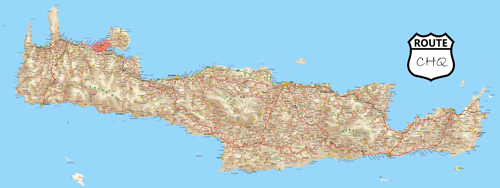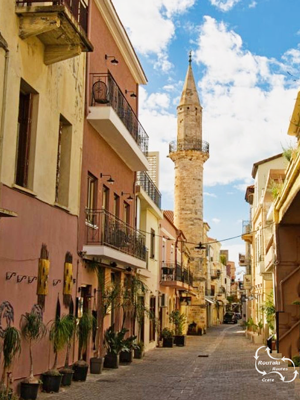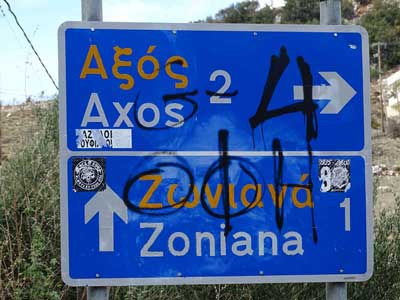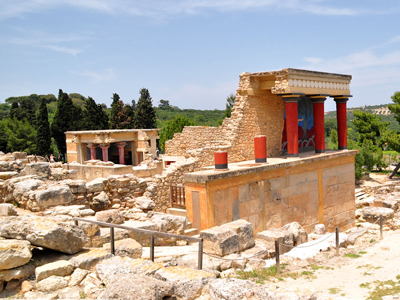
CITY WALK – ‘Chania’
Chania’s Turbulent History: A Tour of the Old Town
What makes Aliki's city walk - 'Chania' so special:
- Discover Chania’s remarkable architecture of the lighthouse, churches, mosques and shipyards
- Stroll through the tiney alley ways and admire the old town’s well preserved houses
- Visit the Maritime museum on Akti Kountourioti street
- Extensive information on the legend behind the Cathedral of Chania
- A historical overview of the cultural history of Chania in the archeological museum
- So many options to take amazing photographs from the well know Lighthouse in the harbour
- The history of Chania’s Jews, which co-existed harmoniously with the Cretan population
- The Venetian families that were powerful here, like the Renieri, Delfino and Colombo
- Learn how Napoleone Canevaro, Theotokopoulos and Daskalogiannis shaped the city
- The ancient city of Kydonia, known for the archaeological remains dating back to the Minoan era
- Get an overview of the Byzantine walls and a few Minoan ruins
- Admire the well painted buildings, constructed between the 13th and 19th centuries
- Conclude with the Mosque of the Janissaries, the oldest Ottaman Turkish building in Crete
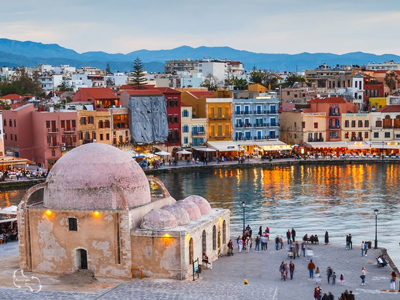
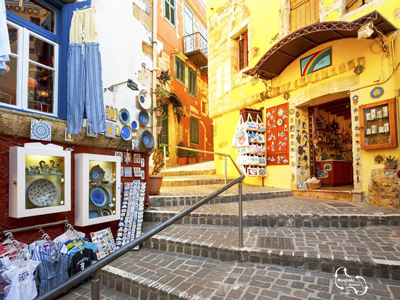
What makes Aliki's city walk - 'Chania' so special:
- Discover Chania’s remarkable architecture of the lighthouse, churches, mosques and shipyards
- Stroll through the tiney alley ways and admire the old town’s well preserved houses
- Visit the Maritime museum on Akti Kountourioti street, showcasing a range of model boats
- Extensive information on the legend behind the Cathedral of Chania
- A historical overview of the cultural history of Chania in the archeological museum
- So many options to take amazing photographs from the well know Lighthouse in the harbour
- The history of Chania’s Jews, which co-existed harmoniously with the Cretan population
- The Venetian families that were powerful here, like the Renieri, Delfino and Colombo
- Learn how Canevaro, Theotokopoulos and Daskalogiannis shaped the city
- The ancient city of Kydonia, with remains dating back to the Minoan era
- Get an overview of the Byzantine walls and a few Minoan ruins
- Admire the well painted buildings, constructed between the 13th and 19th centuries
- Conclude with the Mosque of the Janissaries, the oldest Ottaman Turkish building in Crete


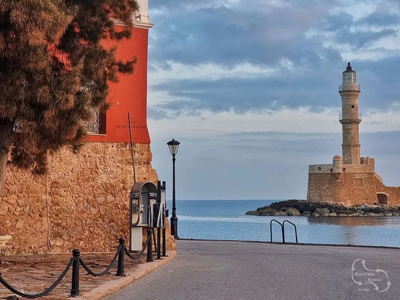
This audio guided city walk starts in front of the municipal market on the south entrance. If you get there with a rental car, there is outdoor parking on the east side of the market that you may try your luck, otherwise you can park in the neighbourhood. If not, try the parking on Nikiforou Foka street.
If you come by bus or taxi there is a bus stop just in front of the market. This tour is a valuable introduction to Chania's turbulent history. Allow 1.5 to 2 hours for this walk. There are plenty of cafes, restaurants and bars en route for a quick (or lengthy!) stop. At the moment of publishing this page, the old market building was under renovation. Still it's situated on a beautiful spot to start this tour.
Click this link to see the starting point on Google Maps.

Before you end up at the harbour of Chania various RAGiFs [Routaki Audio Guide info Files] have already explained what you have encountered or seen along the way. This is what makes a route in the VoiceMap app so unique; you get the right information at the right moment. For example, just after departure, you receive information about the Munical Market, also called the Agora. Your own smartphone acts as a guide, this time with the lovely voice of Aliki, providing information about things you encounter along the way, such as the churches and mosques, why the Byzantine influence was so huge and by doing so, you'll enter the old town like the Venentians did before you. Through a gate called 'porta retimiota'.
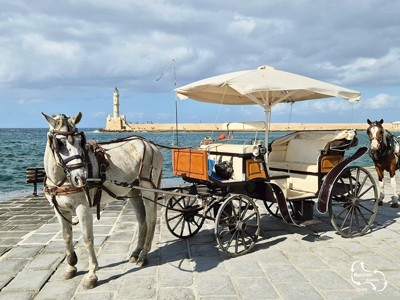
You continue walking and follow the route directions provided and displayed by your own smartphone or tablet. Routaki routes use the VoiceMap app, like Aliki did as well. With this GPS-interactive software, you always know where you are, and the software knows what to play or display.
And all of this offline. You download the app for free, create an account, and purchase this route. The route is downloaded and is at your disposal forever. You can even listen to it in advance in the audio-book version for some anticipation.
The spoken texts, as well as the images, ensure that you stroll around with a safe feeling and you realize that it's almost impossible to get lost. Even bars or kafeneons are mentioned. If you deviate from the route, the app will notify you so you can return to the route.
However, you can also interrupt or stop the route whenever you want. You can take a break, go swimming, take a walk in the parcs, or continue the route on another day. Whatever you want. If you wish to continue the route, simply press the 'Resume' button and the tour will be displayed again.
After a (optional) purchase of some leather boots or purse in the leather street, you wander along and the tour brings you to the square in front of the Church of Trimartyri and Aliki will also tell you about the opposite catholic church, with the blue roof top.
As you continue you come along the Archaeological Museum of Chania, housed in a historic Venetian Monastery. It showcases artifacts from Chania's history, spanning from the Neolithic to Roman periods, including Minoan finds. To continue onto the harbour Square, or Sintrivani, which was once the heart of Chania's social life. After the Jewish quarter this GPS interactive audio tour brings you to Kondilaki street, the main commercial route in Chania’s Old Town, ending at the Venetian walls, built in 1538 to protect against the Ottoman Empire.
Have a look inside a bathhouse from the Ottoman period, now partly converted into a recommended restaurant. At the northwest side of Chania’s Old Port, the Firkas Fortress, once protected the harbor. From there you'll have a view over the port and its Egyptian-restored lighthouse.
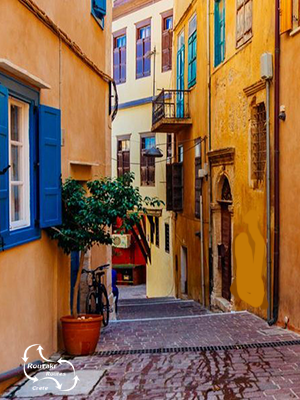
Via a street named after Italian admiral Felice Napoleone Canevaro, you end up at the archaeological site of Kydonia. It reveals a rich history as the earliest settlement on Kasteli Hill, founded by the legendary King Kydon.
While hearing the story of Daskalogiannis, the celebrated shipbuilder who led a Cretan revolt and is honored by having Chania's airport named after him, you arrive at the restored Agia Irini church, preserved by the Greek Archaeological Service.
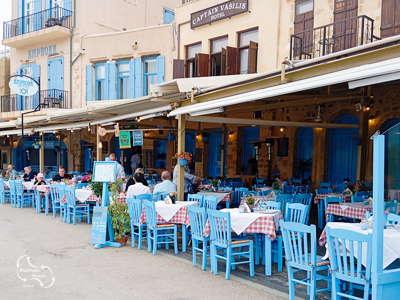
Continue past the Church of Agios Nikolaos, originally built as a Dominican monastery in 1320 and later transformed into the Hugar mosque during Turkish rule, with a minaret added to signify its importance. It was returned to Orthodox Christians in 1918. The last part of the walk is full of little streets and alleys since it is the old Muslim neighborhood called Splatzia. Aliki recommends you to walk all the way to the lighthouse to get to see a great panorama of the Old port.
Finally, after the Grand Arsenal which was built in 1585 and as a school, hospital, and city hall you end up at the Mosque of the Janissaries, The most photographed building of Chania had originally a minaret at the southwest corner, but that was destroyed during the German bombing in 1941. The mosque was used until 1923 and since then it has been used as a cafe, restaurant and tourist office.
Some useful tips:
- Bring some earplugs and your smartphone battery charger.
- Purchase the correct language version of the route (Dutch or English).
- Ensure that the route is NOT set to the audio-book setting.
- Disable automatic screen turn-off (don’t forget to put it back on afterwards).
- Wear appropriate clothing for churches and monasteries.
